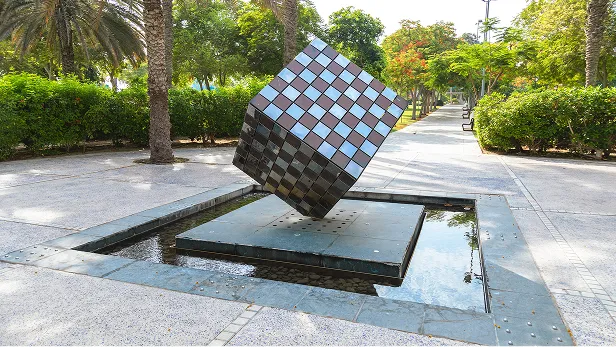.webp)
Decades before skyscrapers, Sheikh Zayed, the UAE’s founding father, understood something fundamental: you can’t build a society without green spaces. So he planted date palms – thousands of them – because they can survive where other trees quickly surrender.
Fast forward fifty years, and that humble impulse has transformed into a national obsession. Palms still anchor the landscape, lining highways, filling private gardens, shading public squares. But now there’s also a whole ecosystem of greenery that Zayed probably couldn’t have imagined: from rooftop gardens and balcony jungles in Dubai Marina high-rises, to desert parks in Sharjah and mangrove forests sprawling along Abu Dhabi’s coastline.

To understand why, you only need to step outside your door in mid-August. Shade here equals survival. Even a single palm tree planted thoughtfully in front of a villa can drop the temperature by several degrees. Multiply that by thousands across a city, and suddenly, urban life feels entirely possible.
It goes beyond simple temperature control. Visit Dubai’s Miracle Garden, for example – arguably the most Emirati approach to gardening imaginable. Here, in the middle of relentless sun, you’ll find 150 million blooms arranged into towering sculptures and intricate mosaics of color. Yes, it’s partly Instagram bait – but more than that, it’s a radical statement: if flowers can flourish in a climate this harsh, what can’t the UAE do?
.webp)
Apart from the spectacle, there are quiet innovations that would impress even the most skeptical sustainability expert. Farms sprouting strawberries and kale out of sand using hydroponics and recycled wastewater. Mangrove forests actively filtering seawater and trapping carbon in Abu Dhabi. Green building codes like Estidama and LEED quietly reshaping architecture, so that even new apartment towers now boast native plants, rooftop gardens, and shaded balconies as standard.
Early attempts, though, involved a lot of trial, error, and stubborn optimism. Lawns imported from Europe turned yellow. Imported trees shriveled within weeks. But through relentless experimentation, the UAE landed on native and drought-resistant plants like ghaf, sidr, acacia, and the eternally hardy date palm – trees that thrive without guzzling water or demanding excessive maintenance.
On a smaller scale, individual homeowners have adapted too. Backyards have shifted from thirsty lawns to desert-friendly havens, full of succulents, herbs, and shaded seating areas that feel more like outdoor rooms than gardens. Irrigation is precise, minimal, carefully regulated. Even the tiniest balcony can become a micro-oasis of aloe, bougainvillea, and aromatic herbs, turning overlooked corners of apartments into cool retreats above the scorching street.
.webp)
This collective effort – by developers, city planners, landscape architects, and even apartment renters – has turned desert landscaping into an expression of identity, a quiet rebellion against the inhospitable climate. It’s a subtle kind of pride: the UAE may not have rivers or rich soils, but it has ingenuity, stubbornness, and patience. Every tree that takes root, every vine that climbs a shaded pergola, is proof that life here can thrive.
As global temperatures rise and cities worldwide grapple with harsher climates, the UAE’s approach no longer looks extravagant – it looks visionary. Other countries are beginning to take note, studying how a place once dismissed as ‘too hot to sustain greenery’ managed to survive. The message is clear: if the UAE can coax strawberries from sand and turn sun-beaten streets into shaded promenades, perhaps humanity’s harshest frontiers are simply invitations to innovate.

.png)
.png)
.png)
.png)
